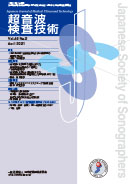
- Issue 6 Pages 531-
- Issue 5 Pages 463-
- Issue 4 Pages 317-
- Issue 3 Pages 183-
- Issue 2 Pages 117-
- Issue 1 Pages 15-
- |<
- <
- 1
- >
- >|
-
Yoshimi Nagashima, Yuriko Sekiguchi, Yayoi Takahashi, Michiyo Takano, ...2021 Volume 46 Issue 2 Pages 117-125
Published: April 01, 2021
Released on J-STAGE: March 17, 2021
Advance online publication: February 06, 2021JOURNAL FREE ACCESSObjective: The difference in results from shear wave elastography (SWE) could be caused by variations in degrees of measurements and procedure conditions. We aimed to improve the reliability and precision of SWE by defining the optimal measurement conditions and assessing the reproducibility among evaluators.
Subjects and Methods: Five sonographers measured shear wave velocity (SWV; m/s) in six persons without liver disease (mean age, 46.5±15.4 years; male, n=2; female, n=4) by ultrasound using an Aplio300 with a PVT-375BT probe (Canon Medical Systems). We calculated inter- and intraevaluator variations in the measured values and compared these values with set scores of 1 or 4 on the region of interest (ROI), in the supine position, with a slightly lateral decubitus position, and number of measurements. We used t-tests and intraclass correlation coefficients (ICCs) to statistically analyze the data.
Results: In four of the five sonographers, the ICC (1,1 and 3,5) of intra- and interevaluator variability, respectively, was >0.7. There was a significant difference in the data from two of the six evaluees and from one of the five evaluators. The position of the evaluee during the procedure did not differ significantly. Single measurements and the average of three measurements differed significantly, whereas the average of three, six, nine, and 12 measurements did not.
Discussion: A high coefficient of variation for liver sections under different test conditions or in selecting the ROI contributed to variations in SWV.
Conclusions: Results were more accurate for persons without liver disease under uniform test conditions, with single measurements, in a supine posture, and when three measurements were averaged.
View full abstractDownload PDF (4437K)
-
Mai Kosai, Tsutomu Kumabe, Ryoko Kuromatsu, Hiroyuki Kawano, Makiko Ya ...2021 Volume 46 Issue 2 Pages 126-131
Published: April 01, 2021
Released on J-STAGE: March 17, 2021
Advance online publication: February 06, 2021JOURNAL FREE ACCESS -
Kenta Muto, Tetsuya Nishiura, Masanobu Yasuo, Shinji Naito2021 Volume 46 Issue 2 Pages 132-136
Published: April 01, 2021
Released on J-STAGE: March 17, 2021
Advance online publication: February 06, 2021JOURNAL FREE ACCESSA woman in her 90s was admitted to our hospital owing to the complaint of difficulty in moving her body after experiencing a fall at home. Further examination with abdominal plain computed tomography (CT) revealed pancreatic duct dilatation at the pancreatic body and tail. However, no blockage was observed in the pancreatic head. Further examination of the dilatation with abdominal ultrasound showed the presence of hypoechoic lesions from the beginning of the portal to the confluence of the superior mesenteric, inferior mesenteric, and splenic veins, which subsequently resulted in inferior mesenteric vein dilatation. Colored Doppler ultrasound indicated the presence of bloodstream in these lesions, which were thought to be tumor embolism. Furthermore, a hypoechoic tumorous lesion, 30 mm in size, was detected and was characterized by irregular shape, internal heterogenicity, and localized wall thickening of the sigmoid colon. Therefore, sigmoid colon cancer associated with tumor embolism was suspected. Contrast CT also demonstrated similar findings. Colonoscopy with bioptic examination was performed, and the tumorous lesion in the sigmoid colon was diagnosed as moderately differentiated adenocarcinoma.
Colon cancer invades the mesenteric vein through vessel invasion in the intestinal wall and metastasized to the liver via the portal vein. As tumor embolus formation requires a certain amount of time, it is very rarely observed as the identifiable tumor embolus in the mesenteric vein without liver metastasis by ultrasound.
In this report, we encountered a case of sigmoid colon cancer with tumor embolism, successfully detected via ultrasound examination, in the mesenteric vein.
View full abstractDownload PDF (6484K)
-
Tomohiro Kurimoto, [in Japanese], [in Japanese]2021 Volume 46 Issue 2 Pages 137-142
Published: April 01, 2021
Released on J-STAGE: March 17, 2021
JOURNAL RESTRICTED ACCESSDownload PDF (10511K)
-
[in Japanese]2021 Volume 46 Issue 2 Pages 143-150
Published: April 01, 2021
Released on J-STAGE: March 17, 2021
JOURNAL RESTRICTED ACCESSDownload PDF (876K)
-
[in Japanese]2021 Volume 46 Issue 2 Pages 151-158
Published: April 01, 2021
Released on J-STAGE: March 17, 2021
JOURNAL RESTRICTED ACCESSDownload PDF (12807K)
- |<
- <
- 1
- >
- >|